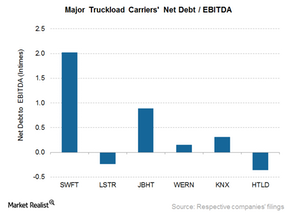Which Is the Least Leveraged Truckload Carrier among Major Peers?
Among truckload companies, Landstar and Heartland have a lot of available cash compared to total debt. Swift and J.B. Hunt have high net debt-to-EBITDAs.
June 30 2016, Updated 4:05 p.m. ET

Truckload companies and leverage
Net debt is calculated by deducting a company’s available cash from its total debt. EBITDA (earnings before interest, tax, depreciation, and amortization) accounts for a company’s earnings from core business operations and is used mainly to eliminate differences between companies’ capital structure and taxation practices.
What does net debt-to-EBITDA multiple indicate?
The net debt-to-EBITDA multiple is a leverage ratio that shows the number of years it would take for an organization to pay back its debt by assuming a constant net debt and EBITDA. In other words, the ratio takes into account a company’s ability to reduce its total debt.
Compared to railroads (UNP), the trucking industry’s capital requirement is usually low. This is mainly due to non-investment by trucking companies in road infrastructure, which is essentially a federal or state domain. Companies with higher debt levels during industry upturns tend to perform better than their low-debt-level peers. But when business slows down, such companies feel the heat of higher interest expenses, unsupported by growth in top line.
Leverage
By looking at the above graph, you’ll notice that Landstar System (LSTR) and Heartland Express (HTLD) have higher available cash on their balance sheets as compared to total debt, and so their net debt-to-EBITDA ratios are negative.
Among the remaining truckload carriers, Swift Transportation (SWFT) and J.B. Hunt Transport Services (JBHT) have high levels of net debt-to-EBITDA, at 2.0x and 0.9x, respectively. But SWFT’s ratio is more than double that of JBHT, and this could be a matter of concern for investors in SWFT. Trucking companies like SWFT have indulged in the disposal of core assets in the wake of lower freight volumes. The company voluntarily prepaid its Term Loan A of $31.2 million in the first quarter of 2016 to reduce its interest expenses.
ETFs
Notably, major US airlines (DAL) and railroads make up 6.7% and 4.0%, respectively, of the iShares Global Industrials ETF (EXI). EXI holds 1.2% and 2.1% in global express delivery companies FedEx (FDX) and United Parcel Service (UPS), respectively.
Now let’s discuss how the current driver shortage is impacting US truckload carriers.
